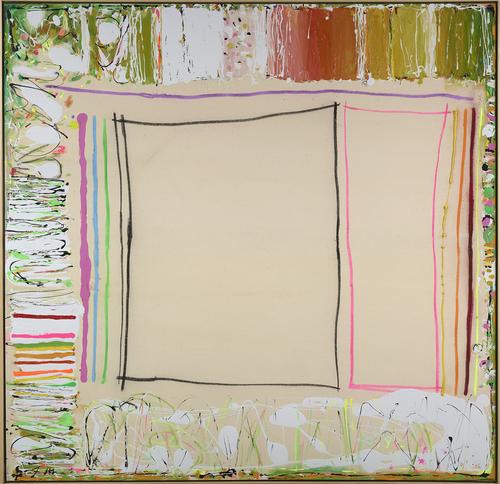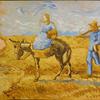
Joyce Weinstein: Country Fields
Berry Campbell is pleased to present an exhibition, opening March 21, 2019, of mixed-media works by Joyce Weinstein. An artist who has received critical acclaim nationally and internationally since the early 1950s, Weinstein is distinguished by her dual commitment to the trajectories of abstraction and plein-air painting. The works on view, inspired by her surroundings in rural Columbia County, New York, demonstrate this convergence. Rendered in oil, washes, impasto, and contrasts of hue and texture, the works represent what Weinstein describes as “another kind of landscape painting, more ‘real’ than literal interpretations.”
In the 1970s, Weinstein created “City-Sunscapes” that evolved from “delicate lyricism” to bold, gestural works expressing the light and air of New York City through paint viscosity and luminosity.[i] In 1992, she moved with her husband Stanley Boxer (1926–2000)—also a prominent post-War figure—to Ancramdale, New York. Subsequently she has continued to express the reality of her surfaces as flat spatial expanses while responding to the “beautiful countryside all around her.” The tension in her work is in its fine balance between these forces, between the physical reality of the canvas itself and the allusions she establishes. The art historian Karen Wilkin has identified this aspect of Weinstein’s recent art, observing that while her paintings never refer directly to the “appearance of the open, rolling countryside surrounding her home, she is obviously acutely attuned to the geometry of the farm fields that divide the landscape and to the shifts in color and light effected by the seasons, weather, and times of day. . . . Yet no matter how persuasive the implicit allusion, we are even more powerfully aware of the abstract, calligraphic quality of Weinstein’s drawing; any incipient reference is cancelled by the forthright ‘presentness’ of the diverse marks.”[ii] An example is First Autumn with a Yellow, which evokes either an aerial perspective on divided farmlands or the “beautiful writing” in a page of the Koran.
Not an artist who takes a remote stance, Weinstein uses an assertive mark-making for which she has a well-deserved reputation as a risk-taker who “refuses to play it safe.” Wobbly, sketchy, and raw lines form contours that approximate fields and countryside, while areas of scratched and scribbled color convey water, light, and organic growth. With both drawn shapes and active lines, Weinstein makes the linen canvas, left bare and unprimed, into space and atmosphere. Her “contrary spirit” is also present in her unrestrained color, her ability to use “fluorescent greens, hot pinks, and danger-alert oranges (and get away with it),” as noted by Wilkin.[iii] Nonetheless, a sense of peacefulness and order often presides in her “country fields” in the different seasons. Piri Halasz observes: “Although scratchy lines convey a certain sense of itchiness or irritation, they are set in a context of quiet reflection. Thus, as a whole, these paintings are harmonious, not grating, organized, and not chaotic. Above all, they are triumphantly human.”[iv] Such qualities are present in Summer Ancramdale Fields, which seems to reconcile tension and liquidity, boundaries and openness, and sustenance and permanence.
Born in New York in 1931, Weinstein studied at City College of New York and the Art Students League. Her first solo exhibition was in 1953 at the Perdalma Gallery in New York City, where she had additional solo shows from 1954 through 1956. She continued to actively show her work in the decades that followed, including one-artist exhibitions in Santa Cruz, California; Houston, Texas; Edmonton, Canada; Cologne, Germany, Chicago; Calgary, Canada; Minneapolis; and Naples, Florida. In 1973, she participated in Women Choose Women. Held at the New York Cultural Center and Farleigh Dickinson University, the show (accompanied by an exhibition catalogue with a text by Lucy Lippard), was the historic first major museum exhibition of contemporary art by women. In 2012, a solo exhibition of Weinstein’s work was held at Hartwick College, Oneonta, New York. Her first show at Berry Campbell Gallery was held in the summer of 2016.
Weinstein has been included in many group exhibitions, at venues including the Museum of Modern Art, New York; the Sarah Institute, New York; Riders Mills Historical Society, New York; Canajoharie Art Gallery, New York; Brooklyn Botanic Gardens, Steinhardt Conservatory; Queens College; the Cork Gallery, Lincoln Center, New York; the Edmonton Art Museum, Canada; the Centro de Creacio Contemporia, Barcelona, Spain; the Cologne Art Fair, Germany; the Queens Museum, New York; Pace University Art Gallery, New York; Sweet Briar College, Virginia; Randolph-Macon Women’s College, Lynchburg, Virginia; Chatham College, Pittsburgh, Pennsylvania; the New School for Social Research, New York; Weatherspoon Art Gallery Museum, Greensboro, North Carolina; Lehigh University, Bethlehem, Pennsylvania; the Kresge Art Center, East Lansing, Michigan; the Hudson River Museum, Yonkers, New York; and the New York Cultural Center Museum.
Weinstein is represented in the permanent collections of the Museum of Modern Art, New York; the Edmonton Museum, Canada, the New Jersey State Museum, Trenton; the Hines Collection, Boston; the Pennsylvania Academy of the Fine Arts, Philadelphia; the Clint Eastwood Collection, Palo Alto, California; the Ciba Geigy Collection, New Jersey; New School for Social Research, New York; Weatherspoon Art Gallery Museum, the University of North Carolina, Greensborough; the Rose Art Museum, Brandeis University, Waltham, Massachusetts; the Centre de Creacio Contemporia Museum, Barcelona, Spain; Chatham College, Pittsburgh; Queens University, Agnis Etherington Art Center, Kingston, Ontario, Canada; and De Saisset Museum, University of Santa Clara, California.
Among her many awards, Weinstein was the recipient of the Lambert Fund Award (1954), from the Pennsylvania Academy of the Arts, Philadelphia, and the fourth annual Susan B. Anthony Award (1983), from the National Organization of Women, New York City Chapter, given “to women who have furthered the cause of women’s equality in the arts.” Weinstein was selected in 1974 to be part of “50 Women Artists,” in the Women Artists Historic Archives, also at the National Organization of Women, New York City Chapter.
[i] These works are well described in Joan Marter, “Joyce Weinstein,” Arts Magazine 53 (October 1978), p. 2. See also Hilton Kramer, “Drawing from the American Mainstream . . . Joyce Weinstein,” New York Times, November 26, 1976, p. 53 and Valentin Tatransky, “Joyce Weinstein,” Arts Magazine 57 (May 1983), p. 7.
[ii] Karin Wilkin, “Introduction,” in Stanley Boxer and Joyce Weinstein (Minneapolis, MN: Douglas Flanders & Associates, 2016), p. 8.
[iii] Karin Wilkin, “At the Galleries,” Partisan Review 57 (Winter 1990), p. 130.
[iv] Piri Halasz, “From the Mayor’s Doorstep,” Art Review Newsletter (December 2008) (online).
- Contact:
- Elisabeth McKee
- em@berrycampbell.com
- 2129242178





100x100_c.jpg)

5100x100_c.jpg)







